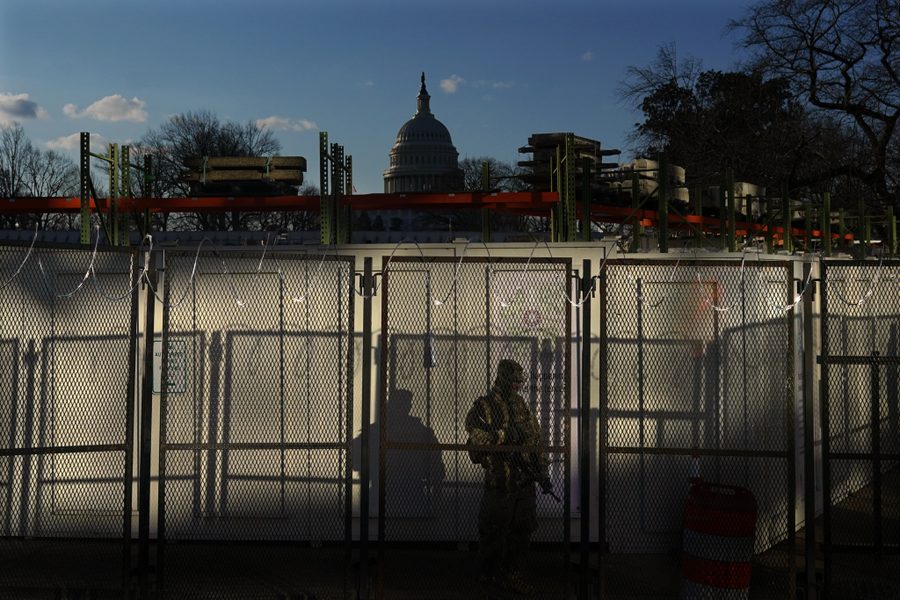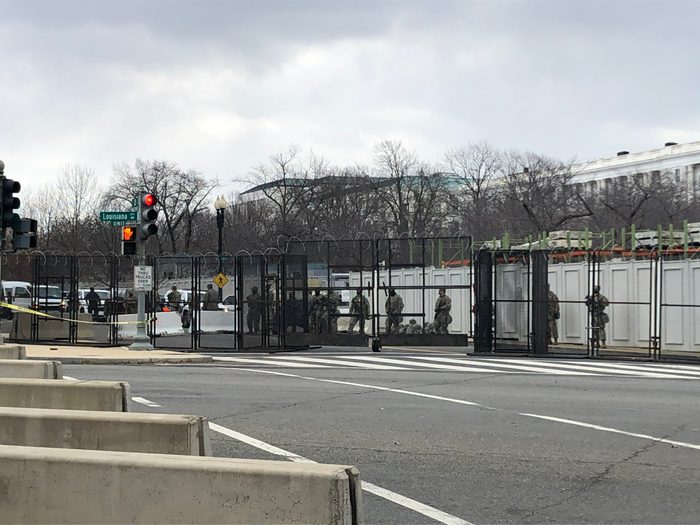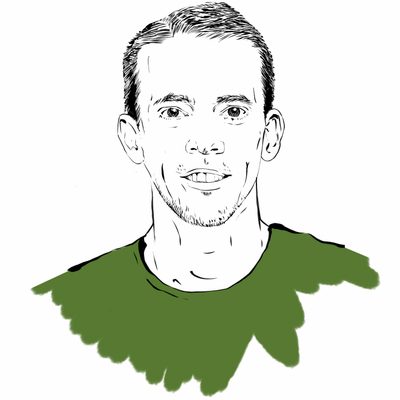A Presidential Inauguration Grows Out of the Barrel of a Gun
Presidents change, but the soldiers stay the same.
Hamilton Nolan

However inspiring you found yesterday’s presidential inauguration probably comes down to how you feel about the military. This may sound odd. Donald Trump was the one who came into office bristling with martial symbolism and macho bluster, while Joe Biden and Kamala Harris arrived on gentle breezes of rhetoric about hope and unity. But for all of Trump’s obsession with the outward trappings of manliness, he never had what Biden had on day one: a military occupation of a major American city.
Most of our national pageantry is made for television, but a presidential inauguration is something that draws its gravity from the participation of the people — Trump’s very first tantrum in office was, after all, about his crowd size. On television, the Biden inauguration may have looked like a shiny procession of feel-good moments, a Lady Gaga concert and poetry reading mixed with a stirring political rally. Many people who watched the broadcast said they were inspired by what it represented. But for those on the ground, where the people’s business happens, your reaction to the entire event was mostly dictated by the question: How comfortable do you feel around heavily armed soldiers and police?
After a year defined in large part by protests over police violence, and a victorious presidential campaign that Biden has said was inspired by opposition to the Unite the Right rally in Charlottesville, his inauguration likely represented the most militarized day in modern American history. Of course, the thousands and thousands of people with guns were there to protect you, this time, but that is what they always say, isn’t it? There is some amount of inherent dishonesty and brushing-under-the-rug of the glaring disconnect between the Democratic Party’s pious embrace of Black Lives Matter and its concerns over state violence and this week’s total lockdown of Washington, DC with National Guard troops manning intersection after intersection. The people with guns are always supposed to be on your side. They don’t always act like it. That’s the problem. We were supposed to be thinking more deeply about this.
Early yesterday morning, a knot of curious spectators stood on a corner of Connecticut Avenue, craning their necks over a procession of black SUVs and police cars to try to catch a glimpse of Biden. I asked one of the DC reporters standing there if she knew the best path through the cordon of checkpoints surrounding downtown. She glanced down at my unadorned neck and then said, in the manner that you would speak to the Official Rube Correspondent of the Hicksville Gazette, “Um, I think you need a credential to get down there.”
Because I try to avoid wearing press credentials out of both a philosophical belief that the experience of a journalist should mirror that of the general public and the fact that I often work at publications not considered fancy enough to be approved for press credentials, I was determined to navigate DC as any other citizen. It was true that you needed a credential to get anywhere close to the Capitol or even the National Mall, where you might be able to see or hear the actual ceremony. The series of scary-looking metal fences and concrete barriers that began all the way up at K Street, though, could be passed through, although the United States government did not seem to want anyone to be aware of that fact.
At every opening in the security fence, there stood a line of soldiers, with M-16s, surrounded by a motley assortment of Secret Service and metro cops and FBI agents and Park Police. Concrete slabs were erected to funnel you down this imposing gauntlet of the security state. There was not a single sign saying, for example, “This Way to Inauguration,” or “Entrance Here,” or “Public Access,” or anything else. There was only the military checkpoint, the armed men in sunglasses, and the mostly empty streets. Even I, a basic white man, had to gather a fair amount of courage to approach the stone-faced soldier behind the nearest metal fence and ask if there was a way to get through.
“Oh yeah, you can walk right in here,” he said, gesturing to the terrifying prison-esque checkpoint. “These are open.”
It does not take much imagination to theorize that the presence of thousands of openly armed soldiers and cops and intimidating, unmarked security barriers on every other block may have sent a signal to American citizens (particularly those who are not basic white men) that they were not welcome at this big Celebration of Our New America. If you are a person who thinks of soldiers and cops as friendly allies there to protect you, perhaps this spectacle was comforting. If not, it was threatening. Had the exact same tableau been in place with Donald Trump in the White House, it would have been easy to see it as a chilling and dystopian scene of America’s decline. As it was, it barely made the news. Don’t forget it, though, because the chilling and dystopian scene can always reemerge.

A few snowflakes fell around 11 a.m., but then the grey clouds parted and the sun came out and the gleaming city, its streets less crowded than an average Sunday farmers market, was revealed. When Joe Biden stepped on stage to take the oath of office, I and a couple hundred other people were standing on North Capitol Street, blocks away, staring at a security fence topped with barbed wire. There were soldiers behind the fence, and a group of riot police in front. Nothing much was happening. The only audible words of the speech were those drifting out of people’s phones as they watched it online. A religious nut was ranting about masturbation. This was the version of the peaceful transfer of power that was accessible to everyone.
Later in the evening, after darkness fell, I strolled back downtown. There were no big protests. All of the reporters who wore body armor did so for nothing. The National Guard members stood by their big trucks, bored and cold, exiled in America for the rest of the night. The people that live in DC would be there longer. In NoMa, a neighborhood of new condos that seems to have sprung up overnight, they sleep in tents under the overpass on L street. They sleep in tents on the little parks along Massachusetts Avenue. They sleep in tents at the intersection by Logan Circle, and they sleep in tents in the patch of grass across from the CVS at Dupont Circle. Those without tents sleep with sleeping bags zipped all the way over their heads, like the man in the Citibank ATM vestibule on K Street, or the man on the steps of the luxurious Camden Grand Parc Apartments by McPherson Square. He was actually inside of the security fence, surrounded by all of the power that America has to offer. Still, he slept on the steps. He slept on the steps before the inauguration, and after the inauguration, and when all of the soldiers leave, he will still be sleeping on the steps.
These are your constituents, Joe Biden. Better get to work.
Hamilton Nolan is a labor writer for In These Times. He has spent the past decade writing about labor and politics for Gawker, Splinter, The Guardian, and elsewhere. More of his work is on Substack.








